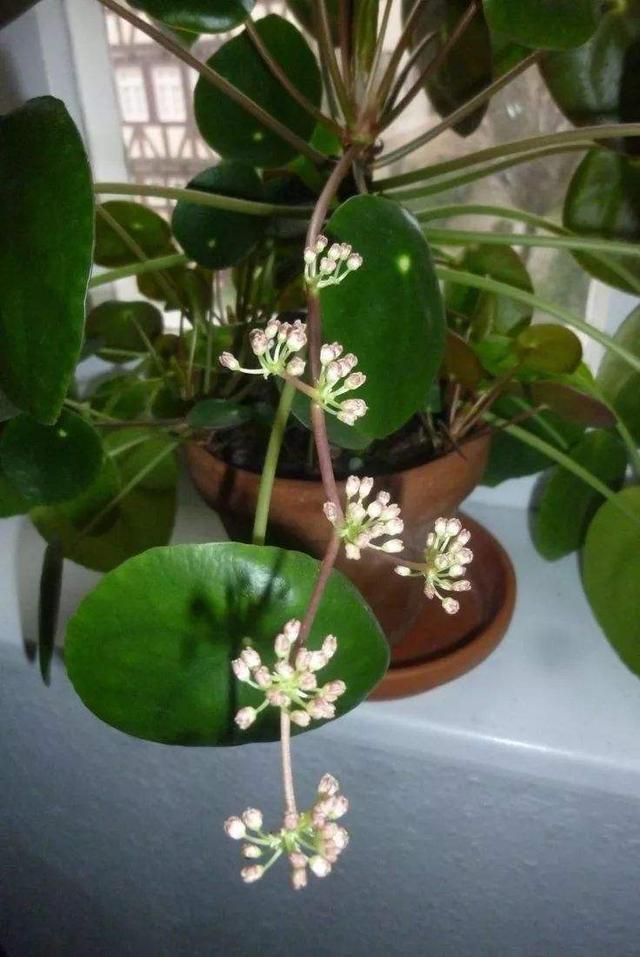Pilea Peperomioides Care & Growing Guide
Written by lisa
Dec 29 2021
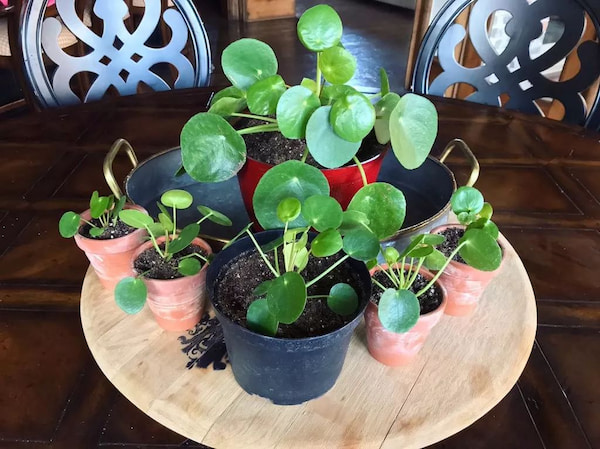
Pilea Peperomioides, a perennial herb, is a very common indoor foliage plant. Its leaves are smooth and green, which is very beautiful. Pilea Peperomioides also has a strong carbon dioxide absorption effect, which can turn waste gas into oxygen, so that the indoor environment becomes more clean and fresh. Most importantly, Pilea Peperomioides is easy to grow and care for. The following will introduce Pilea Peperomioides's natural habitat, care tips, propagation methods, and common problems of growing Pilea Peperomioides.
Pilea Peperomioides is a cold-tolerant and shade-loving plant. Although it likes shade, the plant also grows well in a sunny greenhouse. The suitable temperature for Pilea Peperomioides growth is between 15℃ to 20℃. It is suitable for growing on relatively moist peat soil with good drainage.
The pedicels of Pilea Peperomioides are drawn out near the top of the stem. The peels are stout, about 5 -- 14cm in length, with many branches. The flower branch presents the appearance of tortuous growth, flowers sparsely arranged on the flower branch, like a small rice grain.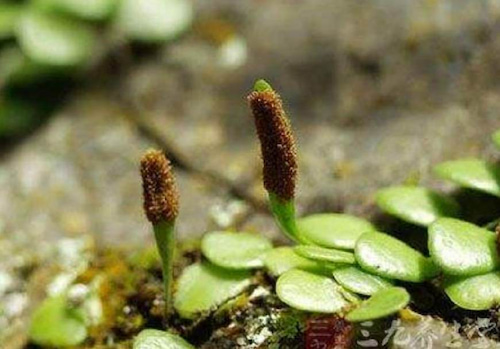
Read More:
How Much Light Does Pilea Peperomioides Need?
Read More:
How To Water My Pilea Peperomioides?
Read More:
Why Does My Pilea Peperomioides Leaves Curling?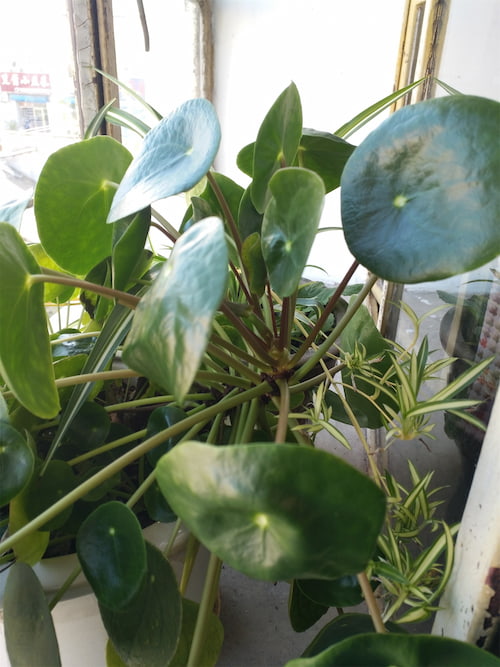
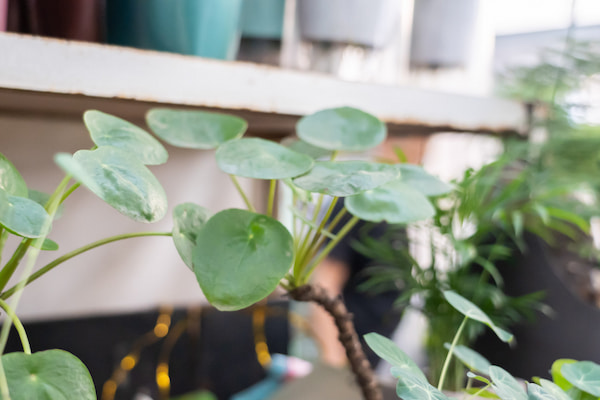
Scale insect occurrence reason: disinfect not in time, insect eggs breed.
Prevention and treatment: spray agents every 8 days, 2 to 3 times. Liquor mixed with water can also effectively kill scale insects, but also does not harm the Pilea Peperomioides.
Read more:
Pilea Plant Care & Propagation Guide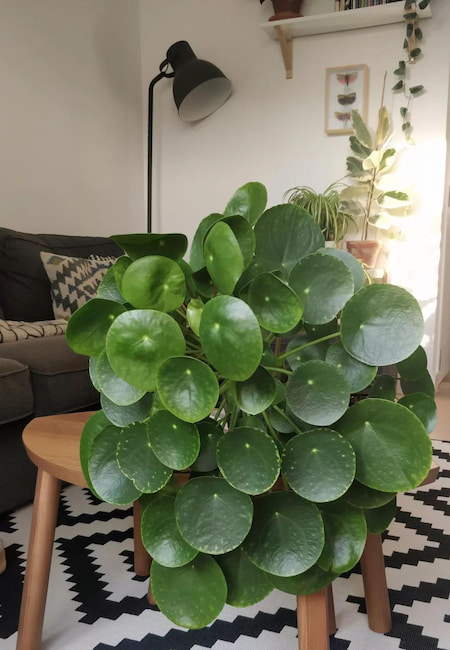
When changing water for Pilea Peperomioides, it is best to put the water in the sun for half a day, if there is no sunshine, it should be put for a day to two days. But if you choose pure water, you can use it directly. But the winter temperature is low, so no matter what kind of water, ensure the temperature of the water and the original water temperature in the vessel be equal or about the same to change water, which is beneficial to the health of Pilea Peperomioides plants.
When changing water, observe the root. If there are other things covering the root, rinse the root with water and put it back in the container. If there are necrotic roots, trim them together with changing water.
When growing hydroponic Pilea Peperomioides in winter, the amount of water should not be too much. The height of water can be completely soaked in the whole root. If the temperature drops to 10℃ in winter, the concentration of nutrient solution should be reduced to the usual 1/2 or 1/3, or even suspended.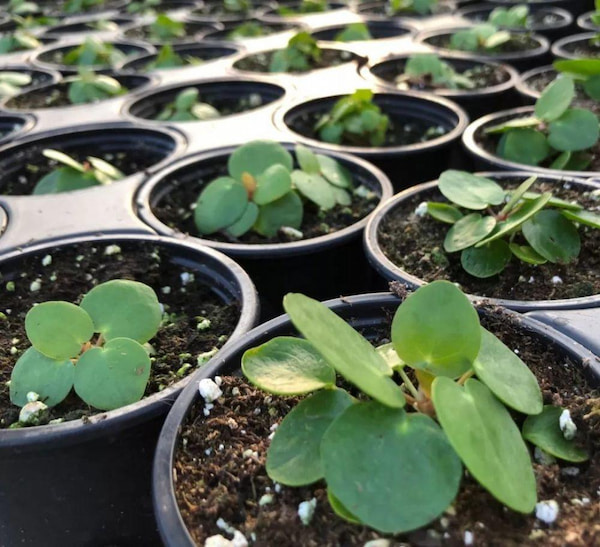
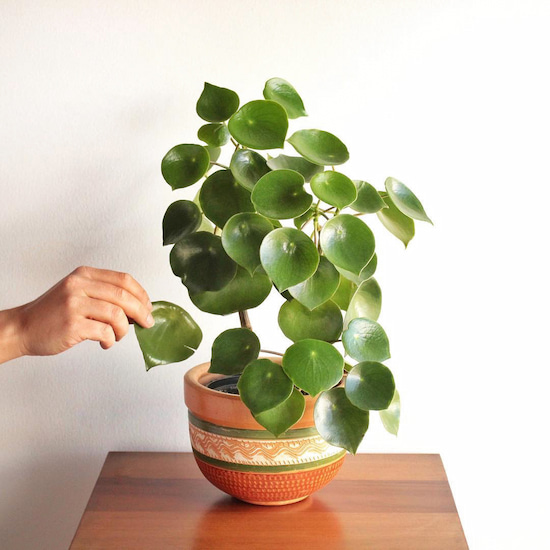
In addition to the need for proper shade in summer, full sunshine care can be carried out in spring, autumn and winter. If the leaves drop less, the Pilea Peperomioides plants can be moved to a place with sufficient sunlight to control the leaf loss.
Pilea Peperomioides Natural HabitatPilea Peperomioides Growth RatePilea Peperomioides FlowerPilea Peperomioides SeedPilea Peperomioides CarePilea Peperomioides LightPilea Peperomioides WateringPilea Peperomioides HumidityPilea Peperomioides RepottingPilea Peperomioides TemperaturePilea Peperomioides SoilPilea Peperomioides PruningPilea Peperomioides FertilizerPilea Peperomioides Pests & DiseasesPilea Peperomioides PropagationGrow Pilea Peperomioides From SeedPilea Peperomioides Propagation from Leaf CuttingPilea Peperomioides Propagation from DivisionGrow Pilea Peperomioides In WaterPilea Peperomioides UsesPilea Peperomioides ProblemsIs Pilea Peperomioides Toxic to CatsPilea Peperomioides White SpotsWill Pilea Peperomioides BloomHow Big Can Pilea Peperomioides GrowPilea Peperomioides Too TallPilea Peperomioides Yellow LeavesPilea Peperomioides DroopingPilea Peperomioides Not Growing
Pilea Peperomioides Natural Habitat
Pilea Peperomioides is a perennial herb, glabrous, tufted, with rhizomes. The stems of Pilea Peperomioides are erect, coarse and unbranched.Pilea Peperomioides is a cold-tolerant and shade-loving plant. Although it likes shade, the plant also grows well in a sunny greenhouse. The suitable temperature for Pilea Peperomioides growth is between 15℃ to 20℃. It is suitable for growing on relatively moist peat soil with good drainage.
Pilea Peperomioides Growth Rate
Pilea Peperomioides is suitable for growing in the pot. Pilea Peperomioides grows rapidly if grow under suitable conditions, which can grow to about 30 to 40cm in size, with petioles 2 to 18cm long and leaves 5 to 8cm in diameter.Pilea Peperomioides Flower
It is not easy to see Pilea Peperomioides blooming. It takes at least three years to grow for flowering and requires patience and proper care. The flowering period of Pilea Peperomioides is in spring and summer, and the blooming time is not very long, usually about 15-20 days. Pilea Peperomioides Flowers arranged on the branches, like a small grain of rice. The color of pilea peperomioides flower is light yellow, which will not send out any fragrance.The pedicels of Pilea Peperomioides are drawn out near the top of the stem. The peels are stout, about 5 -- 14cm in length, with many branches. The flower branch presents the appearance of tortuous growth, flowers sparsely arranged on the flower branch, like a small rice grain.
Pilea Peperomioides Seed
Pilea Peperomioides does have seeds, but the seeds are very small. However, it can not seed growing in any area to seed, only in wet areas, which are more suitable for seed germination. The Pilea Peperomioides seeds are very small, so do not prune the plant after flowering and wait for them to mature for harvest. Since the seeds are very small, sow them shallowly.
Pilea Peperomioides Care
Pilea Peperomioides is an easy-care plant. This section will introduce how to care for Pilea Peperomioides from various aspects including light requirements, watering, temperature, humidity, soil, pruning, repotting, diseases, etc.Pilea Peperomioides Light
Pilea Peperomioides is a shade-tolerant plant. It likes light but not direct strong light. The scattered light is suitable for its growth. If the light is too strong or too shady, the light of the Pilea Peperomioides leaves is easy to fade or disappear; if the light is too shady, the leaves are easy to thin and the petioles become longer, resulting in leaf droop. When the temperature is low in winter, the Pilea Peperomioides plant can be under light all day.Read More:
How Much Light Does Pilea Peperomioides Need?
Pilea Peperomioides Watering
Pilea Peperomioides likes water and is afraid of waterlogging. Keep the basin soil moist, and it is easy to wilt and droop in drought. In severe cases, the Pilea Peperomioides leaves appear wrinkles or yellow and die. When the temperature is below 12℃ in winter, control the times of watering, otherwise it is easy to rot and cannot conducive to overwintering. So how often to water Pilea Peperomioides? Keep the soil moist, but avoid water accumulation To prevent discoloration of the leaves, wilting or even rot of the stems. watering pilea Peperomioides when the soil is both dry and wet. In order to keep air humidity, you can spray water on the leaves. The basin is mainly kept wet during the whole growth period, and it can be relatively dry in winter.Read More:
How To Water My Pilea Peperomioides?
Pilea Peperomioides Humidity
Because Pilea Peperomioides is fond of water and afraid of waterlogging, so it needs to keep pot soil wet, otherwise Pilea Peperomioides is prone to droop caused by drought. Once serious, the leaves will appear curlings or yellow, even dead. Do not plant drooping in dry conditions, but in the high air humidity. You can spary water on the leaves to increase the humidity.Read More:
Why Does My Pilea Peperomioides Leaves Curling?

Pilea Peperomioides Repotting
When To Repot Pilea Peperomioides? You can repot pilea peperomioides in spring and autumn every year. When the side bud of Pilea Peperomioides is still relatively small, do not hurry to change the pot. You can wait for its side bud to grow to 3 centimeters above and repot it in the spring and autumn season. Break off side bud directly, or cut with sharp knife and scissors, then transplant the Pilea Peperomioides plant.Pilea Peperomioides Temperature
The suitable growth temperature for Pilea Peperomioides is between 15-20℃. The overwintering temperature should be kept above 7℃, otherwise, the plant is easy to fall leaves, or even death by freezing. When the temperature is higher than 30℃ in summer, there will be growth stagnation and Pilea Peperomioides leaves will fall off easily. In particular, a sudden drop in temperature can cause leaves and stems to discolor and partially fall off. If the Pilea Peperomioides leaves fall off due to freezing injury, but if there is no damage to the stem, it can care for according to conventional winter maintenance. Avoid direct exposure to strong sunlight in summerPilea Peperomioides Soil
Potting soil for Pilea Peperomioides can use leaf rot soil, garden soil and a little river sand, furnace ash, bone powder mixed into the cultivation of soil. With loose fecund, good drainage and rich in humus sandy loam are better and put tiles on the bottom of the basin to help drain water.Pilea Peperomioides Pruning
In ordinary times, prune pilea peperomioides yellow leaves and dead leaves to avoid infection to other leaves. You can trim the leaves that grow very tall on top, or cut off the ones that stick out around. Timely get rid of the small weed that appears in the basin to prevent snatching nutrition with Pilea Peperomioides.Pilea Peperomioides Fertilizer
Pilea Peperomioides can not bear heavy fertilizer, which should be fertilized a few times with thin fertilizer water. Fertilization should be stopped when the temperature is above 28℃ or below 12℃. Thin liquid fertilizer should be applied once every half month in the growing season. The whole spring and summer is the vigorous growth time of Pilea Peperomioides, so strengthen fertilization and watering. Use 0.1%-0.5% of potassium dihydrogen phosphate solution to spray on leaves. A small amount of nitrogen fertilizer should be applied to Pilea Peperomioides irregularly during spring, and little or no nitrogen fertilizer should be applied as far as possible in summer. Thin liquid fertilizer should be applied once every half month in the growing season, but it should be noted that too much nitrogen fertilizer will cause excessive leaf growth and the Pilea Peperomioides plant lodging. Heavy and raw fertilizer can cause root rot and even death.
Pilea Peperomioides Pests & Diseases
- Anthracnose
- Scale Insects
Scale insect occurrence reason: disinfect not in time, insect eggs breed.
Prevention and treatment: spray agents every 8 days, 2 to 3 times. Liquor mixed with water can also effectively kill scale insects, but also does not harm the Pilea Peperomioides.
Read more:
Pilea Plant Care & Propagation Guide
Pilea Peperomioides Propagation
Cutting and division are common methods for Pilea Peperomioides propagation, which should be carried out in spring.Grow Pilea Peperomioides From Seed
It is possible to grow Pilea Peperomioides from seeds. Pilea Peperomioides seeding is more suitable for wet areas. The seeds are very small and should not be planted too deep in the soil, preferably shallow. Sowing seed too deep will prevent germination. Spray water as much as possible to keep wet after planting, do not water, or it is likely to wash away the seeds.Pilea Peperomioides Propagation from Leaf Cutting
At the end of summer and early autumn, cut off the side leaf on the Pilea Peperomioides stem with a sharp blade carefully and insert it into wet sandy soil in a shaded place. Keep a high air humidity, cutting can root half a month. After a month, you can transplant the new Pilea Peperomioides plant.
Pilea Peperomioides Propagation from Division
The Pilea Peperomioides division propagation is simple and feasible. When the stem or stem segment of the new germination of the side branches grow more than 3 leaves, cut with fibrous roots. The wound can be daubed with furnace ash; With rich humus soil planted in the pot, slightly shade, spray with water, about 10 days the divided Pilea Peperomioides plant can survive.Grow Pilea Peperomioides In Water
Pilea Peperomioides can grow in water. Pilea Peperomioides likes a warm, humid and shading environment. When growing Pilea Peperomioides in water, take out the plant from the original pot, carefully remove the cultivation substrate, and properly trim the long roots after washing them with water. Pour an appropriate amount of water into the hydroponic vessel, and then put the treated Pilea Peperomioides in the hydroponic vessel, fix the plant with small gravel and then the plant slowly survive.- Light: At the beginning of water cultivation, appropriate shade and as the plant gradually grows, it can gradually increase the light.
- Temperature: The surrounding temperature for growing pilea Peperomioides in water can not exceed 30℃, which is not conducive to growth. 20℃ is the best temperature.
- Change water: Change the water twice a week, in order to ensure clean water inside.
- Nutrition: the appropriate addition of nutrient solution to ensure Pilea Peperomioides growth, so as to make the plant grow luxuriant.
When changing water for Pilea Peperomioides, it is best to put the water in the sun for half a day, if there is no sunshine, it should be put for a day to two days. But if you choose pure water, you can use it directly. But the winter temperature is low, so no matter what kind of water, ensure the temperature of the water and the original water temperature in the vessel be equal or about the same to change water, which is beneficial to the health of Pilea Peperomioides plants.
When changing water, observe the root. If there are other things covering the root, rinse the root with water and put it back in the container. If there are necrotic roots, trim them together with changing water.
When growing hydroponic Pilea Peperomioides in winter, the amount of water should not be too much. The height of water can be completely soaked in the whole root. If the temperature drops to 10℃ in winter, the concentration of nutrient solution should be reduced to the usual 1/2 or 1/3, or even suspended.

Pilea Peperomioides Uses
- Pilea Peperomioides can be used for the treatment of liver stones or urinary stones and other visceral stone symptoms, which have a good effect on some reproductive system diseases as Chinese medicine.
- Pilea Peperomioides has a good effect on gonorrhea with some Chinese medicines.
- Pilea Peperomioides can eliminate edema and can treat cough phlegm, chest tightness asthma and other diseases, especially for children.
- Pilea Peperomioides is an easy-care and beautiful foliage plant for houseplant. (Find more best indoor hanging plants here.)
Pilea Peperomioides Problems
Is Pilea Peperomioides Toxic to Cats
Pilea Peperomioides is not toxic to cats or dogs. Although it will release gas, it will not emit toxic gas, and it does not matter if you touch it with your hands. It can be said that it is very safe and you can grow Pilea Peperomioides at home safely, which can absorb waste gas, release O2, purify the air inside, making the environment more fresh and natural.Pilea Peperomioides White Spots
The most likely reason for Pilea Peperomioides’s white spots is scale insects. Scale insects attach to the surface of Pilea Peperomioides leaves, and the secretions pollute the leaves, causing white spots even leaf wilt. You can spray agents every 8 days, 2 to 3 times. Liquor mixed with water can also effectively kill scale insects, but also does not harm the Pilea Peperomioides.Will Pilea Peperomioides Bloom
We know that Pilea Peperomioides leaves are green and beautiful, which is mainly used for foliage plants. But Pilea Peperomioides can bloom. It needs 3-year cultivation to bloom flower with enough patience and corrct care. Pilea Peperomioid flowering period is in spring and summer, generally 15-20 days or so.
How Big Can Pilea Peperomioides Grow
Pilea Peperomioides plant has a strong growth force, which can grow to about 35-40cm tall. The diameter of the leaves can grow to about 5-8cm. But if caring for pilea Peperomioides incorrectly, it will be difficult to grow up. When caring, the plant should be exposed to scattering sun as much as possible, replenished with the water timely, and trimmed away diseased and yellow leaves so that it can grow larger.Pilea Peperomioides Too Tall
With the right amount of water, fertilizer and light, Pilea Peperomioides will flourish. Sometimes the Pilea Peperomioides plant will grow very tall. At this point, you can cut off the tall leaves and stick to the overall level.Pilea Peperomioides Yellow Leaves
There are many cases of Pilea Peperomioides yellow leaves: if the root rot is caused by water retention, it is necessary to stop and pour out the water in the pot. It is best to prune the rot root of Pilea Peperomioides after planting again. If the environment is dark, it is necessary to move to a position with sufficient scattering light, but do not be direct sunlight. If apply thick fertilizer and unripe fertilizer, you need to fill water in the basin, let surplus fertilizer discharge. When serious, you need to repot the Pilea Peperomioides plant with new basin soil.Pilea Peperomioides Drooping
- Lack of sunlight: Pilea Peperomioides is a shade-tolerant plant. However, when growing indoors, it will be not adapted to the full shade of the family light. If the light is insufficient, Pilea Peperomioides will grow poorly and cause leaf drooping.
- Lack of water: In dry conditions, the Pilea Peperomioides plants lack water and their leaves tend to droop and even fall, causing plants to die.
- Excessive fertilizer: Excessive fertilizer directly reduces the ability of roots to absorb oxygen, resulting in Pilea Peperomioides plant drooping and even death.
In addition to the need for proper shade in summer, full sunshine care can be carried out in spring, autumn and winter. If the leaves drop less, the Pilea Peperomioides plants can be moved to a place with sufficient sunlight to control the leaf loss.
Pilea Peperomioides Not Growing
Pilea Peperomioides has a strong growing ability, which can grow to about 35-40cm tall. The diameter of the leaves can grow to about 5-8cm. But if you don't take care of it properly, it will be very difficult to grow and look very small or even not grow. When growing Pilea Peperomioides, the plant should be exposed to more sun, replenished with the water to grow, and trimmed away diseased and yellow leaves so that it can grow larger.Latest Updated
- Benefits of Bugleweed - 7 Science-backed Health Benefits
- Bugleweed Dangers & Side Effects - Is It Poisonous?
- How to Plant Evergreen Trees - What You Should Know
- When to Plant Evergreens - Grow Guide for Evergreen Trees
- 12 Wonderful Evergreen Shrubs for Your Garden
- 12 Popular Evergreen Plants with Pictures for Beginners
- When And How To Prune A Lilac Bush Like a Pro
- How to Grow & Care for Lilac Vine (Hardenbergia Violacea)
- Japanese Lilac Tree (Syringa Reticulata) Care & Propagation Guide
- Shumard Oak Pros and Cons - What to Know
Popular Articles
- Winter maintenance of Antirrhinum Majus
- How to Grow Terminalia Mantaly Tree
- How to Grow and Care for Crossostephium Chinense
- How to grow Antirrhinum Majus in spring
- Peristeria Elata (Dove Orchid) Profile: Info & Care Guide
- Underwatered Snake Plant (Sansevieria Trifasciata) - Signs And How To Fix
- How to Care for Brazilian Jasmine Plant (Mandevilla Sanderi)
- How to Grow & Care for Graptopetalum Purple Delight in Summer
- Rosa Chinensis (China Rose): Plant Growing & Care Tips
- How to Care for Baby Sun Rose (Aptenia Cordifolia)
